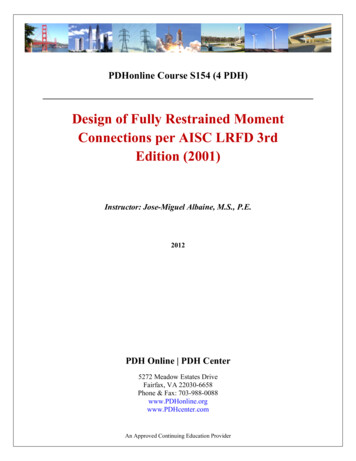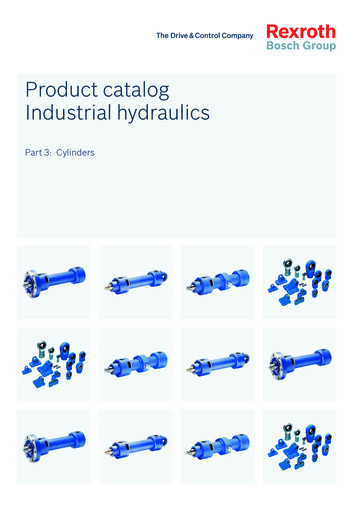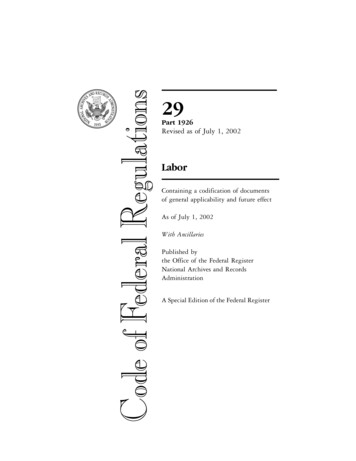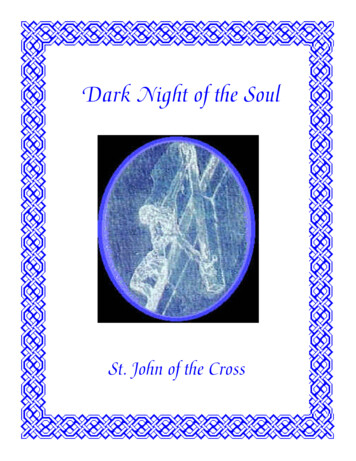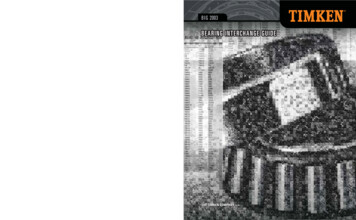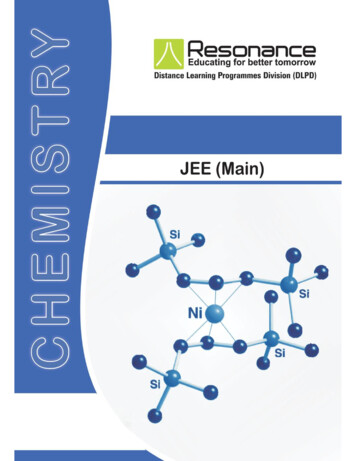
Transcription
Part A : GOC- IElectron displacement in organic compounds :The electron displacement in an organic molecule may take place under the influence of an atom or asubstituent group or in the presence of an appropriate attacking reagent.Types of electronic displacement1.Inductive effect2.Resonance3.Mesomeric effect4.Hyperconjugation5.Electromeric effect (temporary effect)1.Inductive effect :When a covalent bond is formed between the two atoms of different electronegativity then sigma bond pairof electrons are shifted towards more electronegative atom as a result dipole is created between twoatoms. Due to this dipole, sigma bonded electrons in the carbon chain becomes polarised. Suchpolarisation of bond caused by the polarisation of adjacent bond is referred to as the inductive effect.Ex.;Note : (i) It is a permanent effect(ii) It is distance dependent(iii) It is operated through bond not through bond(iv) It is negligible after three carbon atom(v) C–H bond is the reference of inductive effect i.e. polarity of C–H bond is considered to be negligible.Inductive effects are of two types :(i) –I effect :The atom or group which withdraws electron clouds is known as–I group and effect is called–I effect.Decreasing order of –I effect : – – – NO2 –SO3H –CN – CHO – COOH – F – Cl – Br – I – OR – OH – C CH – NH2 – C6H5 – CH CH2 – H.(ii) I effect :The group which releases or donates electron clouds is known as I group & effect is called I effect.Decreasing order of I effect : – C(CH3)3 – CH(CH3)2 – CH2–CH3 – CH3 T – D – HDirection of electron displacements1. -OOCCH2CH2CH32. HOOCCH2CH33.4.5.6.7.8.9. CH 3 CH CH– NO2JEE(MAIN) ELECTRONIC EFFECTS & APPLICATIONS - 1
Applications of Inductive effect :(i) Acidic strength :– I effect Acidic strength (presence of – I groups increases acidic character)O2N–CH2–COOH F–CH2–COOH H3CO–CH2–COOH CH3–CH2–COOHSince NO2 has strong – I effect, its influence will make corresponding acid strongest.(ii) Basic strength : I effect Basic strength (presence of I groups increases basic character)CH3–NH2 NH3;NH3 C6H5NH2(iii) Stability of carbocations :Carbocations are electron deficient species and they are stabilised by effect and destablised by – effect.Because effect tends to decrease the positive charge and – effect tends to increases the positive chargeon carbocation Stability : C H3 CH3 C H2 (CH3 )2 C H (CH3 )3 C CH3 C H2 Cl – CH2 – C H2 C H2 – CH2 – NO2(iv) Stability of carbanion :Carbanions are stabilised by –I effect and destabilised by I effect. Stability : C H3 CH3 C H2 (CH3 )2 C H (CH3 )3 C(v) Stability of carbon free radical :Carbon free radicals are stabilised by I effect. Stability : CH3 CH3 CH2 CH3 (vi) Dipole moment : Greater effect results in greater dipole moment. : CH3NO2 CH3COOH CH3F CH3OH2.Resonance Effect :It is a phenomenon in which a particular compound can be written in two or more structures with identicalposition of atoms. These lewis structures are called resonating structure or canonical structure or contributingstructures. Resonating structuresResonance hybrid(It is the actual structure) OrOrThe resonance structures are hypothetical and individually do not represent any real molecule. But they allcontribute to a real structure which is called resonance hybrid.The resonance hybrid is more stable than any resonating structure.The most stable resonating structure contribute maximum to the resonance hybrid and least stable resonatingstructure contribute minimum to resonance hybrid.JEE(MAIN) ELECTRONIC EFFECTS & APPLICATIONS - 2
Resonance energy :The P.E. difference between the most stable resonating structure and resonance hybrid is called resonanceenergy. The stability of molecule is directly proportional to resonance energy.Conditions for resonance :1. All atoms participating in resonance must be sp or sp2 hybridised.2. The parallel p-orbitals overlap to each other.3. Molecule should have conjugated system (parallel p-orbitals system is called conjugate system)Types of Conjugation :1. Conjugation between C C and C C () 2. Conjugation between ve charge and C C ( 3. Conjugation between lone pair and C C ( 4. Conjugation between odd electron and C C (CH2 CH – 5. Conjugation between negative charge and C C ( ))– CH CH2))Rules for writing resonating structure :(i) In resonating structure only p-orbitals electron are shifted, bond electron are not involved in resonance,therefore the bond skeleton will remain same in two resonating structures.CH2 CH – CH CH2 (ii) The movement of atoms are not allowed.CH2 CH – CH CH2CH3 – CH C CH2(iii) The no. of paired e– are same and no. of unpaired electron are same in two resonating structures.CH2 CH – CH CH2(iv) The octet rule is not violated (for second period element).CH2 CH –(v) High energy structures are rejected as resonating structure and their contribution to the resonance hybridis negligible.Opposite charges on adjacent atoms and similar charges on adjacent atoms are cases of high energy.These are not accepted as resonating structures.CH2 CH – CH CH2Not consider as the resonating structuresJEE(MAIN) ELECTRONIC EFFECTS & APPLICATIONS - 3
Examples : Resonating structures for the following molecules are :O (a) CH3 CH CH C CH3 .(b) H 2 N CH CH C N (c) CH3 – O – CH CH – (d) –2(azide ion)(e) N– N N Rules for stability of resonating structure :(i) The resonating structure without any charge separation is more stable.CH2 CH – CH O(Stability order I II)(ii) The resonating structure with more no. of bonds is more stable and structure with complete octet ofeach atom is more stable.(Stability order II I)(iii) Negative charge on more electronegative atom and positive charge on less electronegative atom aremore stable.(a)(Stability order II I)(b)(Stability order II I)Note : If the rule of electronegativity and rule of octet are contradictory to each other then priority is given to theoctet rule.(Stability order II I) HO – CH – NH2IHO – CH NH2IIHO CH – NH2 (Stability order II III I )IIIJEE(MAIN) ELECTRONIC EFFECTS & APPLICATIONS - 4
(iv) Between two different compounds more conjugated is more stable (provided nature of bonding is same).CH2 CH–CH CH–CH2–CH CH2CH2 CH–CH CH–CH CH – CH3(Stability order II I)(v) In two compounds if one is aromatic and another is non aromatic and conjugation is equal in both thecompounds then aromatic compound is more stable (nature of bonding is same)(Stability order II (Aromatic)(vi) Structure with linear conjugation is more stable than cross conjugation (nature of bonding is same).Cross conjugation : If two groups are in conjugation with a particular group but not conjugated with each otherthen the system is called cross conjugation.CH2CH2 CH–CH CH – CH CH2H 2C CH – C–CH CH 2 (Stability order linear conjugationCross conjugationNote : Equivalent resonance structures make equal contributions to the hybrid and a system described by themhas a large resonance stabilzation.(Stability order : )3.Mesomeric effect :Mesomeric effect is defined as permanent effect of electron shifting from multiple bond to atom or frommultiple bond to single bond or from lone pair to single bond.This effect mainly operates in conjugated system of double bond. So that this effect is also known asconjugate effect and distance independent.Types of Mesomeric effect :(i) m effect(ii) – m effect(i) m group (Electron releasing group) :A group, first atom of which bears -ve charge or lone pair always shows m effect. Due to m effect theelectron density of benzene ring is increased particularly on ortho and para positions.Relative order of m group :– O –NH2 –NHR –NR2 –OH –OR –NHCOR –OCOR –Ph –F –Cl –Br –I –NO(a)(b)(ii) – m group (Electron withdrawing group) :A group that contains double bond or triple bond between hetero atoms will show –m effect. Due to – m theelectron density on benzene ring is decreased particularly on ortho and para positions.Relative order of –m group :—–NO2 –CN –SO2R – CHO —C O –C–O–C–R –C–O–R –COOH –CONH2 OOOJEE(MAIN) ELECTRONIC EFFECTS & APPLICATIONS - 5
(a)(b) –H 2C – CH C .N:.H 2C CH – C ��O(c)4.Hyperconjugation :When a sigma C–H bond of sp3 hybridised carbon is in conjugation with -bond (p-orbital), half filled p-orbitalor vacant p-orbital, then the bond pair e– of sigma C–H bond overlap with adjacent p-orbital. This phenomenonis called hyperconjugation. If may take place in alkene, alkynes, carbocations and carbon free radicals.Like resonance hyperconjugation is also a stabilising effect but the effect of resonance is more dominatingthan hyperconjugation, since in resonance only p-orbital overlap while in hyperconjugation molecularorbitals overlap with p- molecular orbital.* Hyperconjugation is also called no bond resonance or Baker Nathan Effect.Number of hyperconjugative structure Number of -hydrogen atoms at sp3 hybridised -carbon atoms.* Condition : sp3 hybrid C–H or C–D must be present adjacent to the C /C /C C/C C.Important points :(i) It is distance independent.(ii) Not applicable at carbanion.(iii) Hybridisation of atoms remains unchanged. (iv) It is a permanent effect.StructureStructure H3C – C – CH3CH3 – CH CH23CH3 – CH2 – CH CH22CH3CH3 – CH CH – CH36H3C – C – CH3 CH3 – CH2399CH3(i) Hyperconjugation in carbocation :HCH2—CH2Hybrid Structure(ii) Hyperconjugation in alkene :(iii) Hyperconjugation in radical :H CH 2 – C H2 HCH 2 CH2(iv) Hyperconjugation in toluene :JEE(MAIN) ELECTRONIC EFFECTS & APPLICATIONS - 6
Applications of Hyperconjugation effect :(i) Stability of Alkenes : Hyperconjugation explains the stability of certain alkenes over other alkenes.Stability of alkenes no. of hyperconjugative structures CH3H3CH3CCH3 HHydrogenat ionH3CC CH – CH3C CH3C1C CH2H3CH3CStability in decreasing order(ii) Heat of hydrogenation : Greater the number of hydrogen atoms, greater will be stability ofalkene. Thus greater extent of hyperconjugation results lower value of heat of hydrogenation ( Hhydrogenation)CH2 CH2 CH3 – CH CH2 CH3 – CH CH – CH3 (Heat of Hydrogenation)(iii) Bond Length : Bond length is also affected by hyperconjugation (a) Bond length of C(II) – C(III) bond is less than expected(b) Bond length of C(II) – C(I) bond is more than expected(c) C – H bond is longer than expected(iv) Stability of carbocation : Greater number of ‘ ’ hydrogen atoms, greater will be stability of carbocations.(a) CH3(b) CH3 – CH3CH3 (CH3)3 CH3 – CH2 – CH2 – – –(due to resultant of inductive effect and hyperconjugation)(v) Stability of free radical :More the number of -hydrogen atoms, more will be stability of carbon free radical(a) CH3 –(b) CH3 – CH3 –– CH3 CH3 – CH3 – CH2 – (due to resultant of inductive effect and hyperconjugation)5.Electromeric effects :It is a temporary effect. It is defined as the complete transfer of a shared pair of -electrons to one of theatoms joined by a multiple bond on the demand of an attacking reagent. The organic compound having amultiple bond ( double or triple bond) show this effect in the presence of an attacking reagent only. It isrepresented by E and the shifting of the electrons is shown by a curved arrow.There are two types of eletromeric effect.(i) E effect : In this effect -electron of the multiple bond transferred to that atom to which the reagent getsattached. E– CH2 – ECH2 CH2(ii) – E effect : In this effect the -electron of the multiple bond transferred to that atom to which the attackingreagent does not get attached. NCWhen inductive and electromeric effects operate in opposite directions then the electromeric effect dominates.JEE(MAIN) ELECTRONIC EFFECTS & APPLICATIONS - 7
6.Aromatic Character : [The Huckel 4n 2 rule]Aromatic compounds have characteristic smell, have extra stability and burn with sooty flame.Based on the properties of aromatic compounds there are four criteria about the -system.(i) Complete conjugated system (all atoms must be sp2 or sp hybridised).(ii) Cyclic.(iii) Planar.(iv) Huckel rule (4n 2) electrons in the cyclic conjugated -system. Where n an integer 0,1,2,3.Comparision between aromatic, anti aromatic and non-aromatic compounds.Aromaticcompounds (A)Anti Aromaticcompounds (B)Non-Aromaticcompounds (C)1. StructureCyclic, planar allatoms of ring sp2hybridisedCyclic, planar allatoms of ring sp2hybridisedCyclic or acyclicplanar,or non planarsp or sp2 or sp33. MOTUnpaired e s in B.M.O.4. OverlappingFavourable overlapping of p orbitalUnfavourable overlapping of p orbitalSimple overlapinglike alkenes5. Resonanceenergy (R.E.)Very highR.E. 20-25 kcal/molZero4-8 kcal/mollike alkenesUnstablenot-exist atroom temperatureNormal stabilitylike a conjugatedsystemDimerisationreaction to attainstabilityElectrophilic addtionreaction like alkenesCharacteristicsExample6. Stability7. CharacteristicReactionsElectrophilicsubstitution ReactionB.M.O. / Non-bondingM.O.Stability of compounds Aromatic compound Non-Aromatic compound Anti-Aromatic compoundJEE(MAIN) ELECTRONIC EFFECTS & APPLICATIONS - 8
Part B : GOC- II7.Reaction Intermediates :A covalent bond can get cleaved either by : (i) Homolytic cleavage or (ii) Heterolytic cleavage(i) Homolytic bond dissociation : A bond dissociation in which a bond pair electron is equallydistributed to the bonding atoms.e.g., A–B Aº Bºa homolytic bond dissociation generates radicals.(ii) Hetrolytic bond dissociation : A bond dissociation in which a bond pair electron is shifted to oneatom only.e.g., A–B A B A hetrolytic bond dissociation always generate a cation and an anion.(A)Free Radicals :Homolysis of covalent bond results into free radical intermediates possess the unpaired electrons.It is generated in presence of Sun light, peroxide or High temperature(i)(ii)(iii)(iv)(v)(vi)It is Neutral species with odd e—It is paramagnetic in nature due to odd e—No rearrangement is observed generally.Carbon atom having odd electron is in sp2 hybridised state and 7 e— in its valence shell.Usually O2 is used as inhibitorAny reaction if it is carried out in the presence of sunlight, peroxide or high temperature it generallyproceeds via free radical intermediate.Stability of free radical: It is stabilised by resonance, hyperconjugation and I groups. stability order (C6H5)3 C (C6H5)2 CH C6H5 CH2 CH2 CH – CH2 3º 2º 1 (B)Carbocation :A carbon intermediate which contain three bond pair & a positive charge on it is called carbocation. It is a sixelectron having electrodeficient, diamagnetic species and rearrangement can be possible if stability increases.HybridisationExamplesp2, CH3 –spH2 C , HC Stability of carbocations : Followings factors increases the stability of carbocations(i) m effect(ii) Resonance stabilization(iii) Hyperconjugation(iv) I effectGeneral stability order : Note : (1) The carbocation is not possible at following bridge head positions I and II,JEE(MAIN) ELECTRONIC EFFECTS & APPLICATIONS - 9
(2) Carbocations showing aromatic behaviour are exceptionally more stableandare aromatic carbocations(3) Cyclopropylmethylcarbonium ion is also more stable due to bond overlapping with empty p-orbital.Examples of stability order :(a) CH3 – CH – CH3 CH3 – CH – NH223 CH31 CH2(Stability order : 3 4 2 1) CH2––– CH2 .CH3 – C O.4–OMe(Stability order : 1 3 2)–(b)–OMeOMe (c)(C) (Stability order : 3 2 1)Carbanion :A carbon intermediate which contain three bond pair and a negative charge on it, is called carbanion.Hybridisation : Carbanion carbon is in sp3 hybridised state if it is linked to sp3 hybridised carbon or hydrogenatom, where as it will be in sp2 hybridised state if it is linked to sp2 hybridised C-atom due to resonance.HybridisationExamplesp3, CH3 –sp2H2 C spHC , CH2 CH –;Note : (i) Carbanion carbon is in sp3, sp2 and sp hybridised state.(ii) No rearrangement takes place.(iii) It is diamagnetic (8e–) in nature.Stability of Carbanion : Followings factors increases the stability of carbanions.(i) – M effect(ii) Delocalisation of charge(iii) – I effectNote : If -position of a carbanion has a functional group which contains multiple bond (C C, C O, C N, NO2etc) then carbanions are stablised by resonance.,Example of stability order :(a)CH C .1.CH2(Stability order : 1 2 3).(b)(Stability order :1 2 3).CH3–.CH3–(c).(Stability order : 2 1 3 4)JEE(MAIN) ELECTRONIC EFFECTS & APPLICATIONS - 10
(d)(Stability order) : 1 2 3.CCl31(e)(D).CF32(Stability order) : 1 2Carbenes (Divalent Carbon intermediates) :Definition : There is a group of intermediates in which carbon forms only two bonds. These neutral divalentcarbon species are called carbenes. Most carbenes are highly unstable that are capable of only fleetingexistence. Soon after carbenes are formed, they usually react with another molecules.Methods of preparation of carbene :CHCl3 CH2N2N2 : CH2Types of carbene(E)CH2I2 Zn: CCl2: CH2CH2 C OSinglet: CH2 CO TripletShapeBentHybridisationspNature of reactionstereospecificNoneStateExcited stateGround stateMagneticDiamagneticParamagneticNaturePaired electronsDiradical2LinearspNitrenesThe nitrogen analog of carbenes are nitrenes. They are very much reactive since in them octet of N isincomplete.In nitrenes only one valency of N is satisfied.(F)BenzyneThe benzene ring has one extra C – C bond in benzyneClearly, we can see that the newly formed bond cannot enter in resonance with other orbitals of ring. sinceit is in perpendicular plane.It is also important to note that hybridisation of each carbon involved in 'Benzynic bond' is sp2 since theoverlap between these sp2 hybrid orbitals is not so much effective.JEE(MAIN) ELECTRONIC EFFECTS & APPLICATIONS - 11
8.Tautomerism :Definition :Tautomerism is a phenomenon by which a single compound exists in two or more readily interconvertiblestructures that differ in the relative positions of at least one atomic nucleus, generally hydrogen.These two isomers remain in dynamic equilibrium, can be isolated and also give different lab test.Conditions :1. Usually present in the following functional groups2. Basic need for its existence is attachment of these groups with the sp3 hybridised C-atom havingatleast one hydrogen atom as –To get tautomer of above structures -hydrogen atom is shifting to more electronegative atom attachedto double bond (i.e. hydrogen atom from 1st atom to 3rd atom) and double bond is developed between1,2-atom from 2,3-atom. This can be represented as :H–C–C O2 31Keto–C C – OHenolThese two forms (remain in equilibrium) are called tautomers of each other. The interconvertibility oftautomers is a chemical reaction which involves making and breaking of bonds.Ex.O (a) CH3 C CH3( I)OH CH2 C CH3( II)(c)(b)(d)% Enol content in the carbonyl compounds :(i) For monocarbonyl generally it is very less.(ii) Enol content increases with increase in the stability of enol by hyperconjugation, hydrogen bonding,resonance etc.Decreasing order of enol content for above carbonyl compounds is : 3 2 1.JEE(MAIN) ELECTRONIC EFFECTS & APPLICATIONS - 12
(iii) For a carbonyl compound having active methylene group percentage of enol content will be morebecause enolic form has intramolecular H-bonding and also it will be stabilised by resonance.(iv) If active methylene group is more acidic then enol content will be more.For example in acetyl acetoneenolic content is 75–76% while it is 7–8% inacetoacetic ester because ester group shows less electron withdrawing nature than keto group.(v) Percentage of enol content is more in non-polar media while % of keto form is more in polar media.(vi) A carbonyl compound having chiral -hydrogen atom racemizes in aqueous solution.9.Acidic Strength :Definitions :(1) Arrhenius Acid : The compounds which furnish H ion in aqueous solution are called Arrhenius acids.Ex. H2SO4, HNO3, HCl, HClO4 etc.(2) Bronsted Acids : The species, which are proton (H ion) donors, are called Bronsted acids.Ex. NH4 , H3O , etc. All Arrhenius acids are Bronsted acids.(3) Lewis Acids : The lone pair acceptors are known as lewis acids. They have vacant p or d orbitals.Ex. BX3, AlX3, ZnX2 etc.Scale for Measurement of Acid Strength :R–COOHR–COO(Conjugated base)(Acid) RCOO H Ka H RCOOH Where Ka acid dissociation constant.A strong acid is defined as the acid which furnish more number of H ion in aqueous solutionSo, a stronger acid has higher value of Ka , or it has lower value of pKa.pKa –log Ka(More Ka or less pKa i.e. more acidic compound)Note : A stronger acid has more stable conjugate base.Factors affecting stability of conjugate base/anion :Presence of EWG in the alkyl (–R) part of the acid increases stability of anion, and hence increases acidicstrength.EWG — R – C – O(–m, – I)OMore stableERG — R – C – O( m, I, H.C.)OLess stableJEE(MAIN) ELECTRONIC EFFECTS & APPLICATIONS - 13
(A)Acid Strength of Hydrides in periodic table :(1) Along the period from left to right : As electronegativity increase, Ka CH4 NH3 H2O HF.(Ka)Conjugate base/Anion :(stability)(2) Along the group from top to bottom : As size of anion increases, Ka HF HCl HBr HIGeneral acidic strength order is :H2SO4 HI HBr HCl PhSO3H RSO3H HF HCOOH PhCOOH RCOOH H2CO3 NH4 PhOH CH3OH H2O (B) ROH RC CH Ph3CH NH3 RCH CH2 RCH2–CH3Relative acidity of hydrocarbons :Being most electronegative the sp hybridised carbon atom of ethyne polarizes its C–H bond to the greatestextent causing its H to be most positive therefore ethyne is most acidic hydrocarbon.Ka : HC CH H2C CH2 H3C – CH3(C)Acidity of Phenols :The phenoxide ion is more stabilised by resonance than the unionised phenol.Groups which are – I, – m increases acidic character of phenol because effectively dispersing the negativecharge of phenoxide ion. Alternatively I and m groups decreases acid strength.Ex.(a)Ans.acid strength order :Sol.Step 1. III will be least acidic as it has no dispersion of negative charge (No delocalisation of negativecharge).I II IV V IIIStep 2. since – I, – m group will increase acid strength, Nitrophenol will be most acidic followed by phenol,Step 3. Amongst cresol and methoxyphenol, methoxyphenol has m effect of – OCH3 which increases e density hence decrease acidic strengthEx.(b)Ans.acid strengh order :Sol.Step 1 : Notice that CH3 have I effect so all methylphenols (cresols) are less acidic than phenol (I).I III II IVStep 2 : Now amongst cresols p- and o- CH3 are increasing the e density due to their hyper conjugation butortho isomer has viable I effect also, which will help in destabilising phenoxide ion therefore o- is leastacidic. Since at meta position only I works it as least e density amongst the cresol.JEE(MAIN) ELECTRONIC EFFECTS & APPLICATIONS - 14
Ex.(c)Ans.Sol.Acid strength order :II IV III IStep 1. In nitrophenols – I effect of NO2 will help to increase acidic strength hence phenol is least acidicamongst all nitrophenolsStep 2. Only –I effect is applicable in meta nitrophenol so it will be number three. Now –o, –p have both –Iand –m effect of NO2 group over OH and in this particular case para isomer is more acidic than ortho nitrophenol because of intramolecular H–bond.H is trapped by NO2 group.(D)Acidity of carboxylic acids :Conjugate base of carboxylic acid exists as two equivalent cannonical structures (A) and (B). This ion isresonance stablised and resonance hybrid structure is (C). Electron withdrawing group (–M, –I effect) increases acidic nature.Electron releasing group ( M, I effect) decreases acidic nature.Ex.(a) F – CH2 – COOH Cl – CH2COOH Br – CH2COOH I – CH2COOHClCl(b) Cl – C – COOH Cl – CH – COOH Cl – CH2COOH CH3COOHCl(c) HCOOH CH3COOH CH3 – CH2 – COOHCOOH(d)COOHCOOH CH2CH2 – COOH COOHCH2 – COOHComparison between two geometrical isomersEx.Maleic acid :JEE(MAIN) ELECTRONIC EFFECTS & APPLICATIONS - 15
Fumaric acid :NowK1 m K1 fSince the conjugate base is stabilised by intramolecular H bonding.ButK2f K2m Since in maleate ion, after donation oftwomakes system unstable. In fumarate ion this repulsion is less.groups faces each other andAcidic strength of substituted benzoic acid :(i) Formic acid is more acidic than benzoic acid while phenyl acetic acid is more acidic than acetic acid.HCOOH PhCOOH (ii) Electron withdrawing group attached to benzene ring will increase the acidic strength while electronreleasing group decreases acidic strength.(iii) If electron donating group present at para position than it is always less acidic than benzoic acid and alsoit is less acidic then meta substituted benzoic acid.(a) (b) (v) On the other hand if e– withdrawing group is present at meta position then it is more acidic than benzoicacid.(c) Ortho effect :It is common observation that generally ortho substituted benzoic acids are more acidic as compared to theirisomers and benzoic acids itself. This is called ortho effect (which is combined effect of steric hindrance,crowding & electronic effect) in benzoic acid. However exceptions are seen.Ex.(a) JEE(MAIN) ELECTRONIC EFFECTS & APPLICATIONS - 16
(b) COOHCOOH(c) NO2NO2(d) (e) OH(f)Me MeNO2(SIR) NO2 not in plane, so NO2group does notexerts –m with benzene nucleusOHOHOHNO2NO2(g)NO2 O2NNO2O2NNO2NO2NO2(picric acid)(E)Reaction of Acids with salts :NaXSalt of Weak acid HYStrong AcidNaYSalt of Strong acid HXWeak acidRemark : A stronger acid displaces the weaker acid from weak acid metal salt. The weaker acid isreleased out as a gas or liquid or precipitates out as a solid. The weaker acid cannot displace thestronger acid from the salt.(a)2 NaCl H2SO4 Na2SO4 2HCl (feasible)(b)Na2SO4 2HCl No reaction(c)CH3COONa CH3SO3H CH3COOH CH3SO3Na (feasible)(d)CH3COONa PhOH PhONa CH3COOH (not feasible)JEE(MAIN) ELECTRONIC EFFECTS & APPLICATIONS - 17
Que.Which of the follwing reaction is possible ?(a) CH3COOH HCOONa (b) HC C – Na H2O ONaOH(c)SO3Na (d) COOH NO2Ans.(a) Not possible (reverse is possible)10.Basic strength(b) Possible(c) Not possible(d) Not possibleDefinitions:(a) Arrhenius base : Those compound which furinishes OH - ions in aquous solutions are known asarrhenius base.e.g. NaOH, KOH, Ca(OH)2 etc. (b) Bronsted base: Proton ( H ion) acceptor.e.g. NH3, R N H2, R2 N H, R3 N , H2 O , R O H, R – O – R(c) Lewis base: e– pair donor to H ion.; R– O –RHR – O – R H – NH4 NH 3 H e.g.Basicity/Basic Strength(Kb) : It is the tendency to accept H ion. In aq. solution:R – NH 2 H2OBase R – NH3 OH Conjugate Acid (C.A.) [RNH3 ][OH - ]Kb – [where Kb Base dissociation constant].[RNH2 ]pKb –logKbNote : A stronger base always has a weaker conjugate acid and vice versa.General basicity order : Basic Strength in periodic table:(i) From left to right in a period, Eelectron Negativity of elements increases so, Kb (ii) From top to bottom in a group, size increases so, Kb CH 3- is strongest base in periodic table.(b) CH3 P H2 S H Cl(c) F - Cl - Br - -(d) - O H - S H(e) H2 O H2 S Basic strength order is :(a) CH3 NH2 OH F - (A)(f) :NH3 :PH3JEE(MAIN) ELECTRONIC EFFECTS & APPLICATIONS - 18
(B)Carbanion Bases (:C - ) :(a) CH3 – CH2 CH2 CH CH (b) CH3 – CH2 – CH2 CH2 CH – CH2(c) CH2 CH – CH2 CH3 – C – CH2(E.N. , Kb )(delocalised lone pair is less basic)(better resonance due to –ve charge on ‘O’)OCH2-–(d) (ResonanceStabilisation)(C)(localised–ve charge)Basic strength of aliphatic nitrogeneous base :In nitrogeneous compound basic strength is due to presence of lone pair of electrons at nitrogen atom whichaccept the proton N H3 H N H4 Note : (1) Usually 1º amine is more basic than ammonia but if alkyl part of 1º amine is tertiary butyl then NH3 ismore basic due to steric hindrance caused by bulky nature of tertiary butyl groupRNH2 NH3;(CH3)3 C–NH2 NH3(2) Basic strength of nitrogeneous compound depends upon the hybridised state of nitrogenR–CH2 –CH2 –NH2 R –CH2 –CH NH R–CH CH–NH2 R–C N sp3 (localised) sp2 (localised)sp2 (delocalised)sp(3) More electronegative atom will decrease the basic strengthCH3–CH2–CH2–NH2 CH2 CH–CH2–NH2 H–C C–CH2–NH2(4) Cyclic amines are more basic than acyclic amines of same nature (5) Amidines are more basic in nature because their conjugate acid are more stable due to resonance. H (D)Nitrogen (X) is more basic than nitrogen (Y)Basic Strength of Aromatic Amines and substituted Anilines :(a) Aniline :Lone pair of aniline lies in conjugation with a multiple bond, it resides in ‘2p’ atomic orbital, so that it can getresonance stabilisation and hence, basic strength decreases. So, Aniline is a weaker base than NH3JEE(MAIN) ELECTRONIC EFFECTS & APPLICATIONS - 19
(b) Pyridine (C5H5N) : 6- electrons, aromatic ––N:HH A.O. Diagram: N2sp hybrid orbital(localised lone pair)–S.F.:- H– HHLone pair of N in pyridine is localised so it is more basic than aniline.(c) Pyrrole (C4H5N:) : 6- electrons, aromatic (lone pair in 2p A.O.) N–H(sp2)S.F.:-A.O. Diagram:- N–HComplete delocalisation of e—Lone pair of N in pyrrole is delocalised in the aromaticity so it is very less basic than aniline. NHH –N H –:NH2H NH3 –3N ––– sp (4 e )– HHAromaticNon-aromatic– NHAromatic––(d) Substituted Anilines :Electron releasing groups (ERG) m, HC, increases the Kb andElectron withdrawing groups (EWG) –m, – decreases the KbSteric effect of ortho-substituent in Aniline (ortho effect) :G––H2N:––H H–N–HG–H (conjugate acid)(i) Ortho-substituted anilines are mostly weaker bases than aniline itself.(ii)
Carbon free radicals are stabilised by I effect. Stability : CH3 CH 3 CH2 CH 3 (vi) Dipole moment : Greater effect results in greater dipole moment. : CH 3 NO 2 CH 3 COOH CH 3 F CH 3 OH 2.Resonance Effect : It is a phenomenon in which a particular compound can be written in




